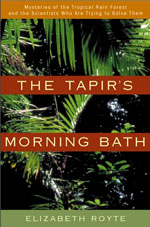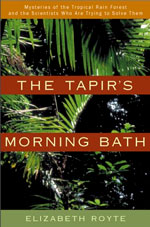It’s easy to glorify field biologists. They travel to exotic locales, hang out with rare wildlife, and further humanity’s understanding of the natural world. What could be more valuable — or more fun?
The Tapir’s Morning Bath brings the discipline gently down to earth. Barro Colorado Island, a six-square-mile island in Panama’s Canal Zone, is one of field biology’s most famous exotic locales. Since the early 1900s, biologists have roamed the island’s rainforest, observing, collecting, and analyzing the tropical frenzy. The accumulated data makes the island one of the best-studied chunks of rainforest in the world, and many field biologists dream of living and working at its research station.
Author Elizabeth Royte, a science writer and a regular contributor to Outside magazine, spent most of a year making her own observations on the island. After slowly earning the trust of several young researchers, she spent hours with them, chasing spider monkeys, counting spiny rats, and tracking bats in the dark.
Although Royte is a biology aficionado, she’s not an uncritical fan, and she constantly questioned the profession’s reasons for being. “Walking the forest with these researchers or their assistants,” she writes, “I would become completely caught up in the excitement of their chase for answers. But at the end of the day, alone in my room, I’d have to ask myself what it all meant … [H]ow could such tiny puzzle pieces of information matter? And who would fit those tiny pieces together?”
Why, she wondered, did her graduate-student friends persevere with their frustrating, sometimes tedious field research? She found that some were fascinated by the intricacies of the rainforest, while others were more interested in seeing their names in prestigious journals. Many of them cared deeply about the fate of the environment, but few believed their arcane studies were going to stop destruction of the rainforest.
Stefan Schnitzer, a Ph.D. candidate studying the distribution of tropical vines on the island, told Royte, “If I wanted to save the rainforest, I wouldn’t be doing what I am. … I’m setting up this experiment as an exercise in thinking. I don’t want a utilitarian reason for everything. Why do we need art? I feel the same way about basic science: It’s good for us.”
Like any good scientist, Royte wasn’t satisfied by simple answers, and her investigation forced her to tackle sophisticated theories of evolution and conservation. Yet The Tapir’s Morning Bath isn’t just for the scientifically obsessed. Royte walks the reader through a detailed discussion of the forces behind tropical diversity, but she also pokes plenty of fun at the behavior of the island’s “higher primates.” Her characters may come off as geeks at first, but they soon develop into diverse and complicated real people. A few months of research on Barro Colorado Island can create or destroy a budding biologist’s career, and this intensity provided Royte with some high-stakes drama.
Royte herself was a full participant in the island’s sometimes-raucous social life, and her personal story complements her scientific musings in surprising ways. Her precise observations, both serious and funny, make her an excellent guide to the rainforest and its denizens. The Tapir’s Morning Bath may not boast the statistical rigor of a typical Barro Colorado Island research project, but it’s a groundbreaking study nonetheless.



